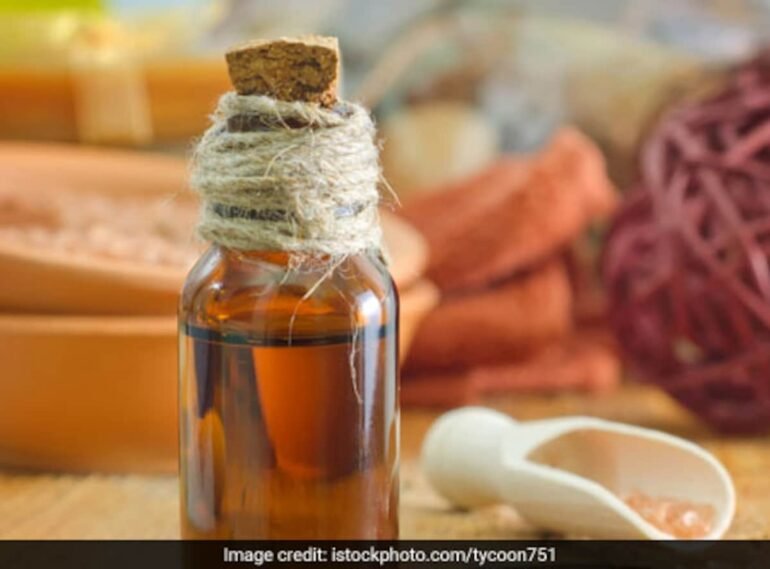Glycerin is a clear, odorless liquid with a thick viscosity. Chemically, it is an organic compound with carbon, hydrogen, and oxygen atoms with a formula C3H5(OH)3. It was discovered accidentally by K. W. Schedule who was a Swedish chemist in 1779.
Glycerin is one of nature’s wonders and is a component of all living cells. It is also found in fermented products such as wine, beer, and bread.
Naturally, it exists as a chemical combination of glycerol and fatty acids, known as triglycerides. (1) It is famous for its areas of applications as it has more than a thousand uses.
Uses of Glycerin
Here are some ways you can use glycerin.
1. Improves dry skin
Glycerin or glycerol is a trihydroxy alcohol that is very famously used in the cosmetic industry for its dermatological benefits. It is known to play an important role in skin care products.
Studies have discovered multiple therapeutic effects of glycerin on the skin such as:
- Protection against irritating stimuli
- Skin hydration
- Skin or cutaneous elasticity
- Repair of the skin barrier
- Acceleration of the wound-healing process
- Antimicrobial effect
Research has also demonstrated that topical application of glycerol-containing products improves skin properties in various skin issues such as skin dryness (xerosis) and dermatitis. So, applying glycerin to your skin, especially in winter, can help hydrate your skin and provide it with other benefits. (2)(3)(4)
How to use:
- Gently cleanse your skin.
- Take some glycerin on a cotton ball, and carefully dab it on your face.
- Let the skin absorb the glycerin for a few minutes.
- Rinse it off with water.
2. Heals cracks on the feet
Glycerol helps heal deep open fissures or cracks on the feet. It is important to manage this condition because it can lead to ulceration or infection if left untreated.
This effect has been demonstrated by one study that showed how a topical product containing glycerol led to complete fissure healing after 4 weeks of application in the majority of the subjects. (4)(5)
How to use:
- Mix 1 tbsp of glycerin with 2 tsp of rose water and ½ tsp of lemon juice.
- Apply this mixture to your cracked heels.
- Let it sit for 1–2 minutes.
- Wear a pair of clean socks.
3. Repairs the skin barrier
Glycerin is excellent for protection against skin dehydration and barrier function repair.
In a study aimed at testing glycerol for its action of promoting skin barrier repair, skin damage was induced and treated with glycerol. The study concluded that glycerol led to a faster reconstitution of the protective skin barrier compared to water. Various other studies have been successful at proving the same.
Since glycerol is hygroscopic, when applied on the skin topically, it absorbs water and creates a stimulus for skin barrier repair. (4)
How to use:
- Wash your face with a cleanser that suits you.
- Pat your face dry with a clean towel.
- In ½ a cup of water, add a few drops of glycerin.
- Dip a cotton pad in this solution and dab it on your skin.
- Let it sit for a few minutes before you wash it off.
4. Prevents dry and chapped lips
The skin on your lip is more sensitive than the skin on the rest of your body because it is much thinner. It is more prone to dryness and becoming chapped and is commonly treated with lip balms that contain glycerin.
Glycerol is a skin protectant that can help prevent chapped, cracked, or windburned lips.
Studies have deemed glycerin useful in exfoliative cheilitis, which is an uncommon ailment that affects the upper, lower, or both lips, causing thick scale formation. Topical application of glycerin was found to be helpful in returning the lips to normal appearance in those who suffer from cheilitis. (6)(7)
How to use:
- Take a cotton pad and put some drops of pure glycerin on it.
- Dab the pad gently on your lips to apply the glycerin.
- Do this every night before going to sleep.
5. Accelerates wound healing
Taking care of your wounds to ensure they heal timely is very important.
The topical application of gels containing glycerin is very famous for healing wounds. This is because glycerin is a humectant that absorbs moisture at the site of application. Any exudate coming from the wound can be managed by glycerin.
The use of glycerin-based gel can be beneficial for several kinds of wounds such as:
- Chronic wounds
- Diabetic wounds
- Ulcers
- Burns
- Trauma wounds
Moreover, glycerin can be beneficial for preventing wounds and reducing scars. (8)
How to use:
- Dilute glycerin with water.
- Apply the solution to your wound by gently dabbing it on the affected area.
6. Helps treat psoriasis
Psoriasis is a very common chronic skin disease that affects millions of people around the world. It is characterized by an overactivated immune system and inflammation.
Glycerol improves dry skin and accelerates wound healing. Because of its skin-protectant actions, glycerol may possibly be useful for the treatment of psoriasis.
This benefit has been confirmed by various studies and also reported by the National Psoriasis Foundation. Research shows that topical glyceryl application can improve psoriasis symptoms. (8)
7. Reduces dandruff
Dandruff is a very common hair condition characterized by flaky scalp skin and itchiness. Research has found that the deterioration of the skin maturation process is related to dandruff and thus needs to be addressed to reduce dandruff.
Glycerin comes in handy for the same. A study has found that a moisturizing leave-on lotion containing a high concentration of glycerol reduced dandruff over an 8-week treatment period when used thrice weekly. An improvement in both skin barrier function and hydration also occurred.
These benefits were observed for as long as a week even after stopping the treatment. Thus, it can be concluded that the use of a glycerol-rich lotion on the scalp can have a significant impact on reducing dandruff. (9)
How to use:
- Mix glycerin with aloe vera gel to form a well-blended paste.
- Section your hair and apply this paste all over.
- You can apply it to slightly damp or dry hair.
- Let the paste stay on your hair for around half an hour.
- Wash your hair like you always do.
8. Conditions the hair
Glycerin has been documented to be employed in aerosol or spray products that include hair sprays at concentrations as high as 30%. This is because researchers suggest that glycerin can be used as a hair-conditioning agent.
Another study shared that conditioning agents in hair products add manageability, gloss, and antistatic properties to the hair. Glycerin was one such agent useful for those who have dry, damaged, or chemically treated hair. (10)(11)
How to use:
- Shampoo your hair as you always do.
- Mix glycerin in your hair conditioner.
- Section your hair and apply this mixture to your wet strands.
- Let it sit on your hair for around 2–3 minutes.
- Rinse with water.
9. Helps treat brittle nails
Nail brittleness is a common issue faced by up to 20% of people, particularly women who are over the age of 50 years.
Brittle fingernails tend to be fragile and are characterized by splitting, flaking, and crumbling of the nails. Brittle nails are also soft as they lose elasticity.
Studies have praised glycerin as it may act as a nail moisturizer and thus is useful in patients with nail brittleness. This is because it is a humectant, which prevents moisture loss. (10)(12)
How to use:
- Mix a few drops of glycerin in water.
- Apply this mixture to your nails and cuticles.
- Do this every time you wash your hands or take a bath.
Most-Asked Questions About Glycerin
Why is glycerin used in medicines?
Glycerol is seen to be a pretty common ingredient in the pharmaceutical sector and can be found in various medicines from OTC cough medication to chronic heart medication. It is used in medicines to improve their smoothness and taste. It also makes tablets easier to swallow.
Is glycerin added to food products?
Glycerin is used in a lot of food and drink products such as:
- Energy bars
- Candies
- Chewing gum
- Condiments
- Creams
- Dried fruits
- Marshmallows
- Beverages
What causes chapped lips?
Causes of chapped lips include:
- Sunlight
- Cold and dry weather
- Frequently licking your lips
- Medical issues such as allergies, hormonal disorders, and autoimmune disorders
- Reaction to a medication
- Vitamin B deficiency
- Dehydration
Can I apply glycerin to my face?
Yes, glycerin is safe to be applied on the skin as per dermatologists.
Can glycerin remove dark circles?
Applying glycerin as an under-eye cream may be helpful in dealing with dark circles according to skin care experts.
Can I leave glycerin on my face overnight?
Dermatologists explain that since glycerin is a humectant, which means it draws moisture, using it on the face overnight for several months can dry the skin a little bit.
Can I eat glycerin?
In one study, there were no signs of toxicity in subjects when glycerin was orally administered after each of 3 meals in 1 day. So, yes, it is safe for oral consumption. (10)
Is 100% glycerin good for the face?
Although glycerin in pure form is safe for the skin, it is still better to dilute it with rose water or a carrier oil, as advised by experts.
What is the best time to use glycerin?
Using glycerin in both your nighttime and daytime routine is great for skin health.
Final Word
Glycerin is an organic compound that is used broadly in the cosmetic and pharmaceutical industries for making soaps, medicines, gels, and moisturizers. It is known for its therapeutic properties and other benefits for the skin since it is a humectant and emollient.
Glycerin is also well known in the food industry because of its use as a sweetener. It can be bought as natural glycerin derived from plant-based oils and as synthetic glycerin from petroleum-based oils.




